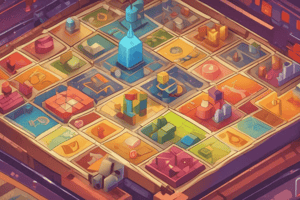Podcast
Questions and Answers
What does it mean to render objects as many times a second as the game speed?
What does it mean to render objects as many times a second as the game speed?
- Objects are rendered every other second to create a cinematic effect.
- Objects remain completely static throughout the game loop.
- Objects are only updated once per second to conserve computational resources.
- Objects are updated multiple times per second to reflect their dynamic behavior. (correct)
How does the game loop handle the rendering of objects?
How does the game loop handle the rendering of objects?
- Objects are rendered with a delay to create a slow-motion effect.
- Rendering happens outside the game loop to prevent performance issues.
- A blank frame is prepared at the beginning, followed by rendering each object sequentially. (correct)
- Objects are rendered simultaneously in random order.
Why does an object's position at game loop n+1 differ from its position at game loop n?
Why does an object's position at game loop n+1 differ from its position at game loop n?
- As a result of continuous movement causing position changes between loops. (correct)
- Because the object is rendered only once in every two game loops.
- Due to the object being temporarily removed from the game loop.
- To create a glitch effect for visual appeal.
What is the purpose of repeating the game loop 60 times per second?
What is the purpose of repeating the game loop 60 times per second?
How is the new position of the ball calculated in the game loop?
How is the new position of the ball calculated in the game loop?
What happens at the beginning of each game loop?
What happens at the beginning of each game loop?
Why is it important for a game to be real-time?
Why is it important for a game to be real-time?
How does a game achieve the illusion of concurrent events?
How does a game achieve the illusion of concurrent events?
What is the role of the game loop in executing concurrent events?
What is the role of the game loop in executing concurrent events?
Why are game events considered pseudo-parallel?
Why are game events considered pseudo-parallel?
Flashcards
Rendering Frequency
Rendering Frequency
Objects are updated frequently to reflect their dynamic behavior in the game.
Game Loop Rendering
Game Loop Rendering
A blank frame is prepared, then each object is rendered sequentially.
Position Change
Position Change
Continuous movement causes position changes between game loops.
Game Loop Repetition
Game Loop Repetition
Signup and view all the flashcards
Ball's New Position
Ball's New Position
Signup and view all the flashcards
Game Loop Start
Game Loop Start
Signup and view all the flashcards
Real-time Game
Real-time Game
Signup and view all the flashcards
Concurrent Events Illusion
Concurrent Events Illusion
Signup and view all the flashcards
Game Loop's Role
Game Loop's Role
Signup and view all the flashcards
Pseudo-Parallel Game Events
Pseudo-Parallel Game Events
Signup and view all the flashcards





